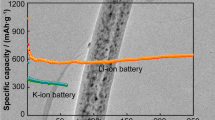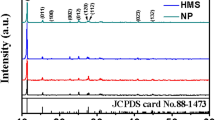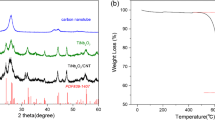Abstract
Potassium-ion batteries (PIBs) exhibit a comparable performance to the commercial lithium-ion batteries. The development of the suitable anode materials for PIBs is long-requested to improve the performance of batteries. In our work, the controlled fabrication of different one-dimensional (1D) Te nanostructures including nanotubes and nanorods is realized by tuning the pH of maternal synthetic solutions. Such a 1D preferential growth nature favors the fast electronic transportation along the longitudinal direction compared with other planar or spherical nanostructures. Moreover, in contrast to nanorods, the Te nanotubes are characterized with hollow channels and thus can release the stress generated during the discharging, retaining the integrity of electrodes. When working as the anode materials for PIBs, the Te nanotube electrode is superior to the nanorod counterpart. Specifically, it offers the cycling performance with about 218.7 mAh g−1 after 500 cycles at 0.1 A g−1 and excellent rate capability (113.2 mAh g−1 at 2.5 A g−1). Even cycling for 1000 cycles at 1 A g−1, the Te nanotube electrode still delivers a notable capacity retention rate of 99.9% with the final discharge capacity stable at 112 mAh g−1.





Similar content being viewed by others
Data availability
The data will be available from the authors with reasonable request.
References
Chu S, Majumdar A (2012) Opportunities and challenges for a sustainable energy future. Nature 488:294–303
Su D, Mcdonagh A, Qiao SZ et al (2017) High-capacity aqueous potassium-ion batteries for large-scale energy storage. Adv Mater 29:1604007
Theerthagiri J, Senthil RA, Senthilkumar B et al (2017) Recent advances in MoS2 nanostructured materials for energy and environmental applications- A review. J Solid State Chem 252:43–71
Dunn B, Kamath H, Tarascon JM (2011) Electrical energy storage for the grid: a battery of choices. Science 334:928–935
Larcher D, Tarascon JM (2015) Towards greener and more sustainable batteries for electrical energy storage. Nat Chem 7:19–29
Poizot P, Laruelle S, Grugeon S et al (2000) Nano-sized transition-metaloxides as negative-electrode materials for lithium-ion batteries. Nature 407:496–499
Armand M, Grugeon S, Vezin H et al (2009) Conjugated dicarboxylate anodes for Li-ion batteries. Nat Mater 8:120–125
Wei J, Zhang PB, Liu YZ et al (2023) Wide-voltage-window amphiphilic supramolecule excluded-volume electrolytes for ultra-durable full-cell aqueous potassium-Ion batteries. Chem Eng J 459:141623
Zhang WC, Liu YJ, Guo ZP (2019) Approaching high-performance potassium-ion batteries via advanced design strategies and engineering. Sci Adv 5:13
Zhu YH, Zhang Q, Yang X et al (2019) Reconstructed orthorhombic V2O5 polyhedra for fast ion diffusion in K-ion batteries. Chem 5:168–179
Jin H, Wang H, Qi Z et al (2020) A black phosphorus-graphite composite anode for Li-/Na-/K-Ion batteries. Angew Chem Int Ed 59:2318–2322
Liu Q, Hu Z, Liang Y et al (2020) Facile synthesis of hierarchical hollow CoP@C composites with superior performance for sodium and potassium storage. Angew Chem Int Ed 59:5159–5164
Hosaka T, Kubota K, Hameed AS et al (2020) Research development on K-ion batteries. Chem Rev 120:6358–6466
Fan L, Ma R, Wang J et al (2018) An ultrafast and highly stable potassium-organic battery. Adv Mater 30:e1805486
Gao L, Wang ZJ, Zhang LL et al (2022) Potassium ion anode versus sodium ion anode: potato starch residue derived carbon material as a case study. J Solid State Electr 26:343–352
Sun L, Song XY, Liu YX et al (2021) Spongy-like N, S-codoped ultrathin layered carbon assembly for realizing high performance sodium-ion batteries. FlatChem 28:100258
Sun L, Xie J, Zhang XX et al (2020) Controllable synthesis of nitrogen-doped carbon nanobubbles to realize high-performance lithium and sodium storage. Dalton Trans 49:15712–15717
Wu JX, He JB, Wang MX et al (2023) Electrospun carbon-based nanomaterials for next-generation potassium batteries. Chem Commun 59:2381–2398
Yang YL, Wang J, Liu SQ et al (2022) Nature of bismuth and antimony based phosphate nanobundles/graphene for superior potassium ion batteries. Chem Eng J 435:134746
Huang XL, Sun JC, Wang LP et al (2021) Advanced high-performance potassium–chalcogen (S, Se, Te) Batteries. Small 17:2004369
Ma LB, Lv YH, Wu JX et al (2021) Recent advances in anode materials for potassium-ion batteries: a review. Nano Res 14:4442–4470
Guo K, Xi BJ, Wei R et al (2020) Hierarchical microcables constructed by CoP@C⊂carbon framework intertwined with carbon nanotubes for efficient lithium storage. Adv Energy Mater 10:1902913
Peng Q, Zhang S, Yang H et al (2020) Boosting potassium storage performance of the Cu2S anode via morphology engineering and electrolyte chemistry. ACS Nano 14:6024–6033
Sun X, Zhang B, Chen M et al (2022) Space-confined growth of Bi2Se3 nanosheets encapsulated in N-doped carbon shell lollipop-like composite for full/half potassium-ion and lithium-ion batteries. Nano Today 43:101408
Hu J, Xie Y, Zheng J et al (2020) Unveiling nanoplates-assembled Bi2MoO6 microsphere as a novel anode material for high performance potassium-ion batteries. Nano Res 13:2650–2657
Mao ML, Cui CY, Wu MG et al (2018) Flexible ReS2 nanosheets/N-doped carbon nanofibers-based paper as a universal anode for alkali (Li, Na, K) ion battery. Nano Energy 45:346–352
Cui RC, Zhou HY, Li JC et al (2021) Ball-cactus-like Bi embedded in N-riched carbon nanonetworks enables the best potassium storage performance. Adv Funct Mater 31:2103067
Bai J, Xi BJ, Mao HZ et al (2018) One-step construction of N, P-codoped porous carbon sheets/CoP hybrids with enhanced lithium and potassium storage. Adv Mater 30:1802310
He YK, Liu XY, Wang S et al (2024) FeS quantum dots as an ultrastable host material for potassium-ion intercalation. J Solid State Electr 28:49–59
Wang MY, Li Y, Yao SS et al (2023) Conversion mechanism of NiCo2Se4 nanotube sphere anodes for potassium-ion batteries. Energy Mater Dev 1:9370001
Fu T, Li P, He H et al (2023) Electrospinning with sulfur powder to prepare CNF@G-Fe9S10 nanofibers with controllable particles distribution for stable potassium-ion storage. Rare Met 42:111–112
Li Z, Liu J, Huo X et al (2019) Novel one-dimensional hollow carbon nanotubes/selenium composite for high-performance Al-Se batteries. ACS Appl Mater Interfaces 11:45709–45716
Liu Q, Deng WZ, Sun C-F (2020) A potassium–tellurium battery. Energy Storage Mater 28:10–16
Liu F, Meng J, Wang H et al (2022) In situ atomic-scale observation of electrochemical (De)potassiation in Te nanowires. Small 18:e2200844
Yu D, Li Q, Zhang W et al (2022) Amorphous tellurium-embedded hierarchical porous carbon nanofibers as high-rate and long-life electrodes for potassium-ion batteries. Small 18:e2202750
Ge X, Yin L (2019) S-doping induced boosted electrochemical redox kinetics in Te1-xSx nanorod cathodes for high volumetric capacity Li-Te batteries. Energy Storage Mater 20:89–97
Wang X, Qian K, Zhou M et al (2021) Hierarchical microspheres constructed by Te@N-doped carbon for efficient potassium storage. Eur J Inorg Chem 2021:2141–2147
Dong S, Yu D, Yang J et al (2020) Tellurium: a high-volumetric-capacity potassium-ion battery electrode material. Adv Mater 32:e1908027
Liu D, Yang L, Chen Z et al (2020) Ultra-stable Sb confined into N-doped carbon fibers anodes for high-performance potassium-ion batteries. Sci Bull 65:1003–1012
Han J, Zhu K, Liu P et al (2019) N-doped CoSb@C nanofibers as a self-supporting anode for high-performance K-ion and Na-ion batteries. J Mater Chem A 7:25268–25273
Wei R, Huang M, Ma W et al (2020) N-doped carbon nanotubes formed in a wide range of temperature and ramping rate for fast sodium storage. J Energy Chem 49:136–146
Wang P, Li C, Dong S et al (2019) One-step route synthesized Co2P/Ru/N-doped carbon nanotube hybrids as bifunctional electrocatalysts for high-performance Li-O2 batteries. Small 15:e1900001
Yu QY, Jiang B, Hu J et al (2018) Metallic octahedral CoSe2 threaded by N-doped carbon nanotubes: a flexible framework for high-performance potassium-ion batteries. Adv Sci 5:9
Liu D, Huang X, Qu D et al (2018) Confined phosphorus in carbon nanotube-backboned mesoporous carbon as superior anode material for sodium/potassium-ion batteries. Nano Energy 52:1–10
Wang YS, Wang ZP, Chen YJ et al (2018) Hyperporous sponge interconnected by hierarchical carbon nanotubes as a high-performance potassium-ion battery anode. Adv Mater 30:1802074
Funding
The authors acknowledge support from the project of Science and Technology Development Program of Traditional Chinese Medicine of Shandong Province (no. 2021M219).
Author information
Authors and Affiliations
Corresponding author
Ethics declarations
Comepting interest
The authors declare competing interests.
Additional information
Publisher's Note
Springer Nature remains neutral with regard to jurisdictional claims in published maps and institutional affiliations.
Supplementary Information
Below is the link to the electronic supplementary material.
Rights and permissions
Springer Nature or its licensor (e.g. a society or other partner) holds exclusive rights to this article under a publishing agreement with the author(s) or other rightsholder(s); author self-archiving of the accepted manuscript version of this article is solely governed by the terms of such publishing agreement and applicable law.
About this article
Cite this article
Han, S., Wu, Q., Yun, Y. et al. One-dimensional Te nanostructures as fast anode materials of potassium ion batteries. J Solid State Electrochem (2024). https://doi.org/10.1007/s10008-024-05902-w
Received:
Revised:
Accepted:
Published:
DOI: https://doi.org/10.1007/s10008-024-05902-w




